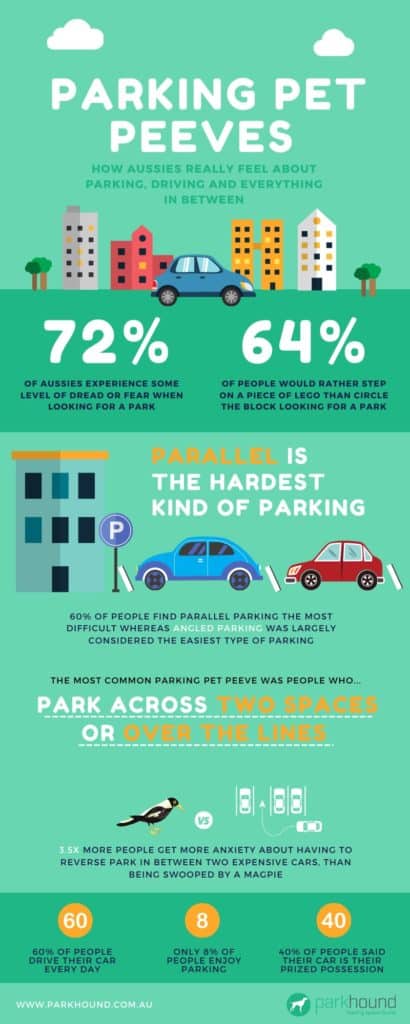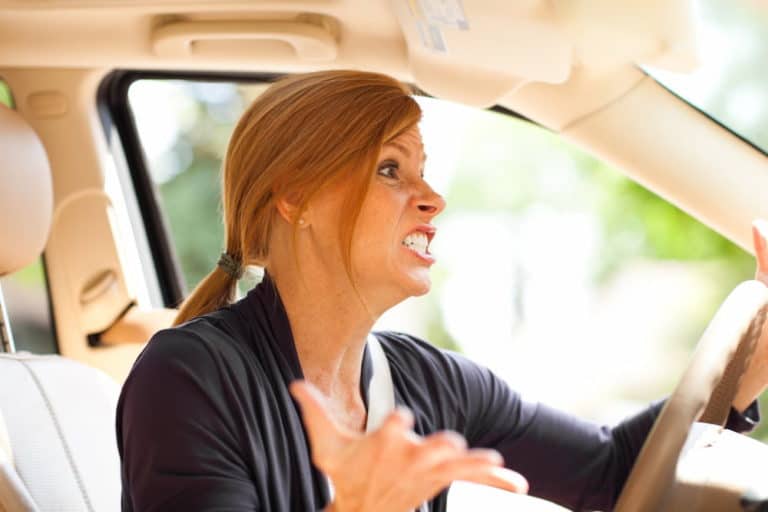Are Australians the angriest drivers on the road? Is road rage on the rise? How does parking play into road rage incidents? We don’t know about you but we had a lot of questions about aggression on the road. We sat down with Dr. Amanda Stephens, a research fellow from Monash University’s Accident Research Centre, to get some answers to our many questions and find out some practical ways to overcome anger on the daily commute. Here are 9 that you can begin to implement in your own daily life, or help those around you with.

Dr Amanda Stephens
Monash University Accident Research Centre
Table of Contents
What is road rage?
While this may seem like a straightforward question, Dr Stephens raised that it can often be more complex. “Different people have different conceptualisations of what road rage is. Some people see it as every aspect of aggression – even small acts like honking when angry, while others see it as the extreme behaviours you see on the news.”
“We tend to define it as the latter and distinguish between more minor aggression and road rage. Minor aggression being honking or swearing. Then there’s more risky aggressive behaviour such as speeding or tailgating. Road rage is the extreme behaviour where people are trying to physically hurt someone.”
Should you be worried about road rage?
Road rage is no small issue. In fact, in a recent survey of 1000 local drivers, more than 70 per cent said they had been a victim of road rage.
Road rage may be stereotyped to those with aggressive personalities and short fuses, but anyone can display aggressive behaviour on the roads and more often than not it’s sparked by a driver having a bad day or external situations that are causing them stress.
It is difficult to determine if road rage is increasing, or whether it is simply reported more often thanks to the wide use of dashcams, mobile phone cameras, and social media.
Are Australians the angriest drivers?
There hasn’t been a comprehensive cross-cultural study on aggression on the roads since 2003 so it’s difficult to make definitive conclusions about road rage in Australia compared to other countries. Dr Stephens did remark that in her research around the world, she’s found that people seem to consistently feel like aggression is worse in their own country than anywhere else. In the study conducted by Gallup1, Australia did rank second when asked if they had ever shown aggressive behaviour to other drivers, with 60% answering yes. We came in second only to the US, where 68% of people admitted they’d shown anger on the roads.
Dr Stephens has also found in her research that the triggers that cause drivers to become angry seem to be very similar all over the world. “Acts of driver discourtesy tend to be the most anger-provoking, followed by traffic obstructions, hostility from other drivers and slow driving. Drivers also tend to have similar patterns of how they express this anger.
“Most drivers will more frequently try to deal with this in an adaptive way by telling themselves not to worry about it, or not to get involved2.”
The most common “aggressive” expressions that were found are:
1. Verbal (i.e. swearing under breath, yelling or gesticulating)
2. Using the vehicle to express anger (e.g. driving fasting, tailgating, etc),
3. Personal physical (so trying to scare the other driver, or trying to get out of the car).
More severe behaviours were less common, as is to be expected.
What state in Australia has the highest rates of road rage?
Dr Stephens found through a recent research paper that for the most part road rage incidents are fairly consistent around the country.
“We published results of a national survey asking about specific behaviours of tailgating, chasing another driver when angry, honking when angry and expressing anger any way possible and found very few differences across the states. Honking was reported by 61% to 75%, expressing anger by 51% to 72% of drivers, tailgating 40% to 51% of drivers – again relatively similar across the States and Territories3.”
However, there was one clear difference between the states, with the Northern Territory showing significantly higher incident rates of chasing other drivers.
“Chasing another driver showed the largest differences across jurisdictions with 9% in Tasmania and 28% in the NT having done this at least once over a two year period.”
Road Rage and Parking – A Dangerous Combination
How are road rage and parking linked?
In a recent survey we conducted, the results were pretty clear. Australians do not enjoy parking! While it might not come as a surprise to you, seeing just how much stress and anxiety many people associated with parking was astonishing.
We asked our community what their least favourite parking ‘Faux Pas’ were. Here are the answers that seemed to come up over and over again:
- Parking across two spots or over the lines
- Large cars trying to park in small spaces
- Double parking strangers
- People taking too long to park in an easy spot
- People parking in handicap or reserved parking
Answers like “The classic ‘cut the line’ in the Westfield at Christmas time – guaranteed road rage!”, showed us once again how much emotion is associated with parking in, and especially incidents with other drivers. We asked Dr Stephens what the link between road rage and parking and while there hasn’t been too much research on this yet, she did have this to say:
“Interestingly, we know that aggression is often an expression of anger and researchers from the US have identified that having someone steal your parking spot is an anger-provoking situation. It fits into a broader category of discourtesy from other drivers, which is known to provoke anger and aggression in drivers.4”

How does road rage affect you?
Aside from the clear dangers of aggressive driving and the potential to cause serious accidents, there are many knock on effects from being on either the giving or receiving end of a driver’s anger.
Dr Stephens explained that even a much smaller experience can affect your whole day:
“Research in the US has shown that annoyances from driving can influence how you interact with co-workers and make you more aggressive, or influence interactives with family.5 I have also found that anger or annoyances from one drive can influence how you react in subsequent drives, so for people who drive a lot during the day, this means anger can accompany you on other drivers and may lead to more anger and aggression.

Never stress about finding a park again!
Sign up now and get 10% off your first month with Parkhound.
Practical tactics to deal with road rage
1. Your outlook before the drive
The first tactic may seem pretty straightforward, but the impact it can have on your commute can be immeasurable. Taking some time to check in with yourself and notice key triggers can have a big impact on your drive. Next time you feel the urge to lash out or confront another driver, take a moment to think about why this is happening and what other things are contributing to this frustration. Dr Stephens confirmed that personal problems have a big impact on our driving behaviour:
“When we get in the car, our stresses and annoyances accompany us – if we are fighting with a loved one, or stressed about a work situation these can influence how we react to other drivers. Angry drivers may view the behaviour of other drivers as being more hostile or deliberate, and so how we feel can influence how we react. Recognising these cycles is important in improving our experiences while driving.”
Dr Amanda Stephens was recently involved in the campaign “Travel time, it’s your time,” a collaboration between Monash University Accident Research Centre, the NRSPP (National Road Safety Partnership Program) and Budget Direct. The goal of the campaign is to give drivers the tools to rethink their anger and aggression.
“Driving is often how we start and end our day, and what happens on that drive can affect how we are at work and home. Being angry or aggressive while driving not only increases the risk of crash through misdirected attention or dangerous behaviours, but it can influence our interactions after the drive is over. It’s not worth it.”
“Two of my favourite points from the campaign are: The majority of drivers drive up to 25,000km per year: will you spend that time in anger?” and “in every other car is another person; think before you rage.”
2. Music
This one is good news for all you music buffs out there! A study conducted by researchers in Brazil for ‘Complementary Therapies in Medicine’ found that listening to music can reduce your risk of cardiac stress while driving. Listening to music has also been shown to keep drivers focused on long, boring drives. While this is the case for most music, a different study did find that drivers who listened to aggressive music with lyrics featuring violence showed increased driving speed and spent longer above the speed limit than other drivers. So while music definitely gets the green light from us in terms of beating road rage, pay attention to your music choices and opt for background music or acoustic music over loud and energetic music.
3. Allow enough time for the drive
It’s agreed upon by many sources that ensuring you have enough time to complete your journey comfortably, reduces the stress of your drive and therefore the likelihood of you becoming involved in a road rage incident. Too often we have unrealistic expectations of how long a trip will take us, or don’t factor in things like heavy traffic, accidents that cause delays and how long it might take you to find a park and walk to your destination.
Making sure you leave yourself plenty of time also gives you the option to take some time before you leave to cool off if need be. A study for the University of Michigan found that 89% of students agreed that experiencing an aggressive emotion shortly before getting into a car had a very significant impact on someone’s driving style. More than three-quarters of the students suggested that experiencing a situation that brought on feelings of anger or frustration within 10 minutes of their drive would make them more likely to get aggressive with a slow driver or someone who cut them off. Taking out time pressures means that if a situation like this happens, you can take the proper time to calm down before getting behind the wheel.
4. Just breathe
This one should come as no surprise. You’ve likely heard of the old “count to ten” trick or something along those lines. This isn’t just some whimsical tale told to kids. Taking a purposeful moment to breathe and relax is actually a very effective strategy to regain your clarity of mind. In fact, studies have shown that mindfulness improves cognitive function as well as decreasing the amount of distracting thoughts drivers have. All of this leads to safer driving practices and therefore fewer incidents involving road rage.
To further back this, a series of studies took drivers with high levels of aggression and had them attend therapy sessions teaching them either relaxation or cognitive-relaxation therapy. The study found that both treatments helped reduce the frequency and intensity of these drivers outbursts and even helped them with anger management longer term. With so many resources out there, like meditation for stressed-out drivers and white noise tracks, there’s plenty of ways to take a calm moment, allow yourself to breathe and shake off any negative feelings.
5. Put space between you and other cars
This one might be a bit of a flashback to when you first learnt to drive. Hopefully, you’re familiar with the ‘three-second rule’ (and no…it has nothing to do with eating food off the floor in this particular case). It is a rule of thumb for drivers to make sure you’re leaving enough space between you and the car in front of you. It factors in your reaction time in case you need to make a sudden stop. Following this practice has been shown to reduce the risk of collision and also the severity of any injuries if a crash were to occur.
We mention this rule here because it can be a great guide to help avoid tailgating and road rage. Reminding yourself of this concept when you’re driving is a good way to give others their space and reduce the possibility of any kind of incident occurring. If someone does show aggressive behaviour towards you on the road, come back to this rule and remember to give them plenty of space, not to engage and to pull over and take a breather if need be.
6. Eat a balanced breakfast
Our mind and body are very closely connected and what we eat has a direct effect on our mood and how we deal with situations around us. Research has shown that consistently eating food high in trans fatty acids, such as highly processed junk foods, has been linked to higher levels of aggression.
Similarly, feelings of ‘hanger’ can also make us act impulsively and follow aggressive impulses we normally might not. Eating a balanced diet full of fresh fruit and vegetables and making sure to have a good hearty meal before you set out on your commute can help you keep road rage at bay. And bonus tip… keep a few healthy snacks in your car in case you get desperate.

7. Get a full night’s sleep
Not getting a full night’s sleep affects nearly everything we do when we are awake, and driving is no exception. In fact, one of the culprits most often blamed for the high levels of road rage we seem to be experiencing as a society is how common it is to sacrifice sleep to make room for work, socialising and other activities. Currently, up to 40% of Australians are said to not be getting enough quality sleep and combining this with the 1-2 hours of driving we found most Aussies do each day – the results can be disastrous. Sleep deprivation can manifest during driving as tiredness, drowsiness and reduced concentration, which can all impact your ability to perform a cognitively demanding task like driving. The probability of being involved in a car accident and sleepiness have been directly linked, and studies have shown that drowsiness can impact your driving performance at the same level or even more so than being under the influence of alcohol.
So, with all of that said, make sure you’re prioritising your sleep and getting a full 8 hours each night. This will help make sure you’re clear-headed for your next drive and making the best decisions possible.
8. Mix up the way you drive your normal routes
While you might think that accidents are more common when you’re driving somewhere new, complacency while driving has been shown to lead to higher levels of accidents and mistakes while driving. Statistics have shown that with less traffic on the road during COVID, Australians have actually been making more dangerous decisions than usual and often this is within their local area. Driving through streets that you’re very comfortable with can lead to more distractions and less patience for other drivers.
Hence, to avoid road rage accidents try mixing up the route of your morning commute or taking a different way to the local shops. While it might seem trivial, this will mean you’re more focused on the drive itself, less likely to make mistakes and therefore less likely to become involved in an incident with another driver.
9. Attending a defensive driver course
A defensive driver course provides attendees with the skills and knowledge required to safely drive vehicles in a variety of different road conditions. Most courses cover topics like managing hazardous conditions, safe driving techniques and up to date knowledge of road laws. The main goal is to keep drivers safe on the roads. Courses usually include practical knowledge too, showing you how to navigate out of dangerous driving situations in a simulation.
These courses are not just for young and inexperienced drivers. Even for many older drivers or those with ample experience, a course like this can be incredibly beneficial for shaking off any bad driving habits you’ve picked up, and helping drivers learn about all of the technology that most modern cars are now equipped with.
In addition, Dr Stephens and her team are currently evaluating a reducing aggressive driving program (RAD) and are looking for interested people to participate. They are looking for licenced drivers, over 18 and who may get angry while driving. If this sounds like you or someone you know, find more information about the program here.
Conclusion
Road rage is no joke, and you’ve likely experienced some form of it for yourself. There are things we can all do to make our roads and highways safer places. To take a line from NRSPP and Monash University’s recent campaign, travel time is your time – it’s not worth it.
If you’re looking to take some of the stress out of your morning commute, consider booking a long term parking spot right near the office or uni with Parkhound. At Parkhound, we match you up with local hosts in Melbourne, Brisbane or one of our 10,000+ other locations around Australia so you can save 40-60% on your parking. Drive to work knowing your dream parking space is already reserved and waiting for you!
Sources
- EOS Gallup Europe. “Aggressive Driving Is A Global Issue.” 2003.
- Stephens, A. N., & Sullman, M. J. (2014). Development of a short form of the driving anger expression inventory. Accident Analysis & Prevention, 72, 169-176.; Deffenbacher, J. L., Stephens, A. N., & Sullman, M. J. (2016). Driving anger as a psychological construct: Twenty years of research using the Driving Anger Scale. Transportation research part F: traffic psychology and behaviour, 42, 236-247.
- https://acrs.org.au/files/papers/arsc/2017/Stephens_00104_EA.pdf and Stephens, A., & Fitzharris, M. (2019). The frequency and nature of aggressive acts on Australian roads. Journal of the Australasian College of Road Safety, 30(3), 27.
- Deffenbacher, J. L., Oetting, E. R., & Lynch, R. S. (1994). Development of a driving anger scale. Psychological Reports, 74(1), 83-91
- Hennessy, D. A. (2008). The impact of commuter stress on workplace aggression. Journal of Applied Social Psychology, 38(9), 2315-2335.; Stephens, A. N., & Groeger, J. A. (2011). Anger-congruent behaviour transfers across driving situations. Cognition & emotion, 25(8), 1423-1438.Stephens, A. N., Trawley, S. L., Madigan, R., & Groeger, J. A. (2013). Drivers display anger‐congruent attention to potential traffic hazards. Applied cognitive psychology, 27(2), 178-189.

